
Howard Jones
Carpe Diem
by Anil Prasad
Copyright © 2015 Anil Prasad.
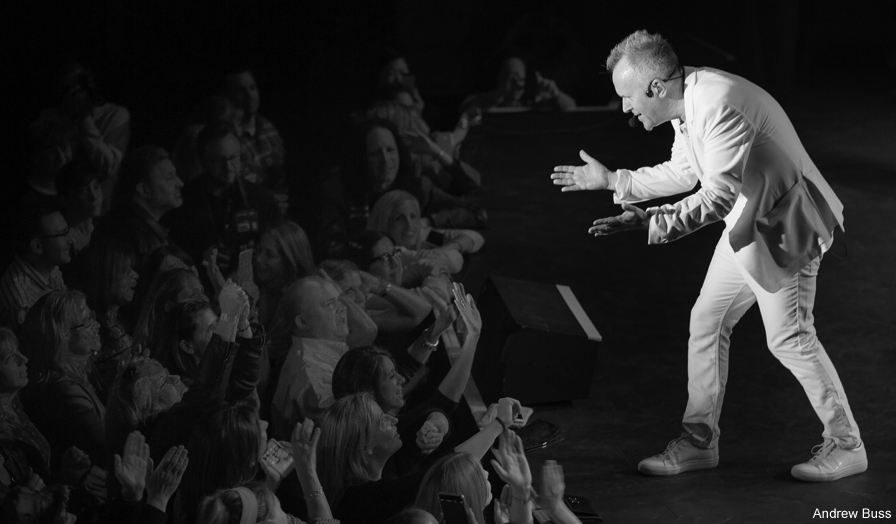
Howard Jones’ 1989 hit single “Everlasting Love” is blasting out of the speakers lining the outdoor terrace of M Café, a trendy macrobiotic eatery in Beverly Hills. It’s an appropriate musical welcome as I arrive to meet Jones for an interview to discuss his new multimedia project Engage, the most expansive and bold undertaking of his storied career to date.
Minutes after the song wraps up, nearly on cue, Jones arrives at the restaurant. He’s sharply dressed in a blue jacket, gray t-shirt and jeans, looking much younger than his 60 years.
Shortly after Jones sits down to begin the conversation, a grumpy Steve Martin strolls in to order a “Big Macro” veggie burger to go. In fact, all manner of beautiful people weave in and out, including a star-struck couple that recognizes Jones. He’s a perfect gentleman to the fans and was happy to chat with them about the many gigs of his they’ve attended.
Jones, of course, is well-known for a series of colossal hit albums and 15 top-40 hit singles throughout the ‘80s and ‘90s. The British musician’s work also played a pioneering role in the introduction and acceptance of synthesizers and sequencers in pop and rock recordings and performances.
It would be easy for Jones to rest on his laurels and rely solely on performing his hits. However, that’s simply not an option for him. He’s spent years working on the recently-unveiled Engage, an interactive experience that crisscrosses myriad disciplines. It’s part album, film, mobile app, book, and live performance. During its most ambitious moments, it incorporates multiple realms simultaneously.
Musically, Engage is Jones’ biggest artistic statement to date. It brings together the worlds of pop, electronica, contemporary classical, and ambient. In the film and during live shows, Engage also features state-of-the-art visuals, including computer-generated imagery, as well as original ballet and modern dance footage.
Boiled down to its essence, Engage is about imparting personal, humanistic philosophical perspectives. In fact, at various points during the film and show, quotes from people such as Mahatma Gandhi, Daisaku Ikeda and Søren Kierkegaard are featured. Jones’ own worldview is what holds the entire experience together—one he communicated in great depth during this conversation.
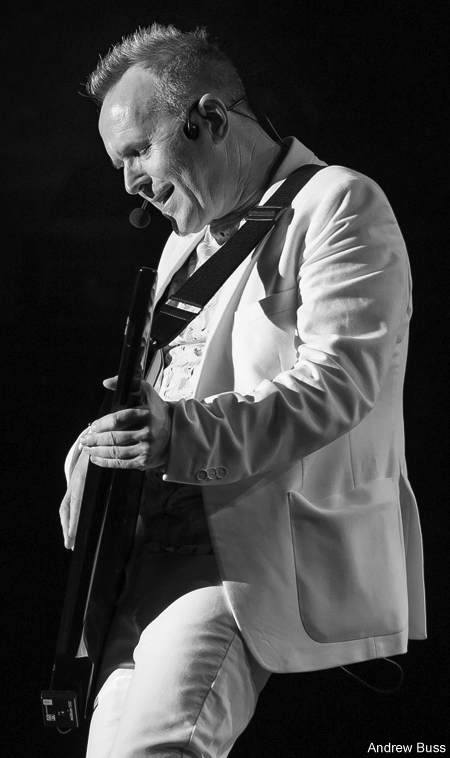
You recently turned 60. What does that milestone mean to you?
It feels like the most significant birthday ever for me. I’m aware there’s a limited amount of time left in which I can be working at full capacity. My voice and health are good, so it’s absolutely imperative that I don’t hold back now or leave anything in the locker room. It really hit me about a year before the birthday. It’s one of the reasons I did Engage. I thought “Right, I’ve got to challenge myself to do something beyond what I’ve done. Don’t be afraid.” I’ve always been a bit of a risk taker, but now I think is the time to really go for it. It’s the main message in the song “Seize the Day” from Engage. Live life in the present and don’t put things off, because the chance may not come again.
What are the keys to remaining relevant to a broader audience when you’re in this age category?
It’s about creating work that reflects the times we live in. Today, more people are spending time online in a virtual life. In a sense, that’s not really good for us. It’s great to have the technology and use it, but the best thing about being a human being is our interaction with each other. It’s about face-to-face contact and dialog. We must remember that. That’s something I wanted to get across in Engage. It’s also the idea behind the song “Human Touch.” It’s a very electronic track, with robot graphics, but the message is the most important part. Virtual life is okay and the digital link will do fine sometimes, but our development as human beings comes from actually being around one another. It’s what defines us and pushes us forward. We don’t always agree about everything, so we have to modify our thinking sometimes, but that’s the point. We can’t exist on our own in a vacuum. There’s no chance for development if we do.
There is also a lot of disrespect and indifference toward human life in the world and that has to be challenged within what I do, too. Perhaps the most important thing is addressing equality for women. It’s on my mind a lot and will be part of my future work.
Do you wish you could escape the “’80s icon” tag?
It’s not a burden. I think it’s a fact of life and I’ve got to deal with it. It’s up to me to change that perception—if it’s worth changing. It has to do with the time I became well-known. It was when I had all of the hits, but it’s not the whole story. The people who really know me, know that. So, I don’t worry about it too much. In a way, it’s a great advantage, because it means I have an audience to speak to. It’s up to me to reveal anything else I’ve got to them.
Did you feel it was a risk to introduce a large chunk of new music to your audience when you began performing Engage?
I have to trust the audience and not be afraid. The first time I performed it, I was nervous about whether or not they would be able to handle that much new stuff. But I did my audience a disservice by being worried. They completely went with it. A lot of people said they preferred it to the hits. I was encouraged by that. What I’m learning is it’s very good to put a lot of effort into understanding who my audience is and what they’d like to hear. It’s a two-way street. It’s a partnership and it has to be that way. It’s the modern way for any artist to survive.
Engage has a compact 35-minute running time. Why did you choose that length?
I didn’t set out for it to be that length, but I didn’t want things to drag out unnecessarily. I wanted the pieces to be short and sharp. There are sometimes very few lyrics in the songs. I didn’t feel like I needed to extrapolate. I felt that sometimes a few statements would work and be assimilated quickly, with the music reinforcing them. At one point, I thought maybe it should be a bit longer and wrote another piece, but it didn’t work within the flow, so I chose to keep it the way it is. I did add another piece to the film, which is “The Moon Over Kamakura.” I needed music for the credits, and that piece came naturally. It extended the Engage film and album to 40 minutes.
You said when you were first thinking about Engage that you were determined to showcase yourself as you are now. Elaborate on that idea.
Engage is a reflection of all the things I’ve learned since I started playing and writing music, as well as the other art forms that have influenced and inspired me. That’s why we’ve got the dance elements in the work, the influence of Steve Reich in “5 Pianos” and the classical music I studied from age seven to 21. Cinema is probably the most vibrant art form at the moment and the way people combine music and film has influenced me as well. I wanted to include all of that in Engage. The other important things featured in Engage are the lines of philosophy that run through it from people like Gandhi, Daisaku Ikeda and Kierkegaard. They’re the bedrock of why I wanted to do this in the first place.
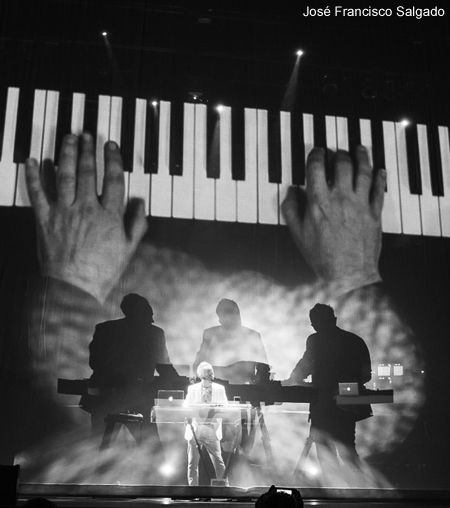
The Engage film is unique compared to typical concert movies. Describe the approach you took.
We didn’t want to do a live DVD capturing the show because you can’t really do it that way given all the screens involved. So, we decided to do a hybrid which involved the original source films for each piece and elements of the live show superimposed, as well as some of the audience interaction. I call it the Engage movie, rather than a live DVD.
“5 Pianos” is the most atypical piece of music you’ve created. Describe what made you want to record a Steve Reich-inspired track.
I went to see a Reich concert in London. The ensemble was doing a new Reich piece based on the music of Radiohead called “Radio Rewrite.” It was performed by a classical group who had commissioned the work. I loved the writing and was quite fired up the next day. I really wanted to write a piece of music that was my version of his minimalist concept. I added some electronics and had it be a bit more tuneful because that’s what I do. Honestly, I wrote it in two hours. It just flooded out. It’s my favorite piece on Engage, because it’s always revealing something new. You can pick out new themes every time you hear it. I love that piece. I’m so proud of it. I’ve got plans to perform it live with five pianists in the future.
Were you concerned about adding a piece like that to your live set?
Yeah, a bit. One guy in Los Angeles said he was struggling a bit with that one, but he added “I keep playing it and it’s growing on me.” [laughs] I think it’s about getting your mind into a slightly different place when you hear it. I feel people are behind what I’m doing now. I will still write songs, because that’s what I do as well, but I will be doing more things like “5 Pianos” because it’s liberating and brings together everything I love.
Tell me about the message you’re communicating in “Sister Brother.”
I was thinking about the idea of what it means to truly respect one another, absolutely and fundamentally. It’s about cherishing the person in front of us, whoever that is, and giving them your full attention. I like to put ideas out there straight and not dressed up in a poetic sense. The music and visuals take care of that. I wanted it to be “Sister Brother,” not “Brother Sister.” That’s significant to me. The older sister is nurturing the younger brother. That’s the subtext of the choreography. Sometimes he slightly stumbles as he dances and she cradles him, as well as him cradling her. It’s a very equal, beautiful thing. People are in tears watching that. I wanted people to be really moved by it.
Describe the meaning behind “The Moon Over Kamakura.”
It’s a quote from Daisaku Ikeda, the president of Soka Gakkai International, the leader of the type of Buddhism that I practice. It’s about not giving up, because if you give up halfway, you won’t be able to see the moon over Kamakura, which is a really beautiful site in Japan. It’s his poetic way of saying stick to your guns and see it to the end. I thought that’s what I’ve got to do with Engage. I’ve got to get it to people and not be put off by anything so I can see the moon over Kamakura.
Engage was your first foray into fan-funding. What appealed to you about that concept?
It was an experiment to use a PledgeMusic campaign to fund it. It appealed to me straight away because it invites the artist to be very responsible towards the fans. It also invites fans to be responsible towards you, and I think that’s great. It’s such a good relationship to develop and it opened up many things that could be offered. I was able to offer a bit more of myself in that we did studio days in which people flew in from all over the world to hear how we put Engage together. We had them in the studio, played it to them in 5.1 surround on a really good system, and they would ask questions. I learned a lot about how they feel about what I do and what they want from me. I also said what I’d like to see from them. I also got a chance to create hand-written lyrics and artwork. I’ve always enjoyed calligraphy, so it was great to do that.
One other thing I did was create bespoke piano solos for people. It was taking the idea of doing a painted portrait of somebody, but using a piano solo to communicate who they are instead. I did four of them in person. The subject would be in the studio with me. We’d spend an hour or more talking about their life. Then I’d compose the piece in front of them, record it into the computer, edit it a bit to tidy it up, but not really changing it. It was an amazing experience. I realized how powerful that was. I’d like to do more of that. People really felt like the piece was reflecting who they were.
The other important thing is that I felt responsible for every delivery of the new album and book. It wasn’t like it was being put out there anonymously. If people didn’t get it or I missed signing one, I knew personally that it was an issue and that’s a good thing. I’ll probably use this model for future projects. I’ll evolve the ideas and take into consideration the lessons I learned from Engage to make it even better next time.
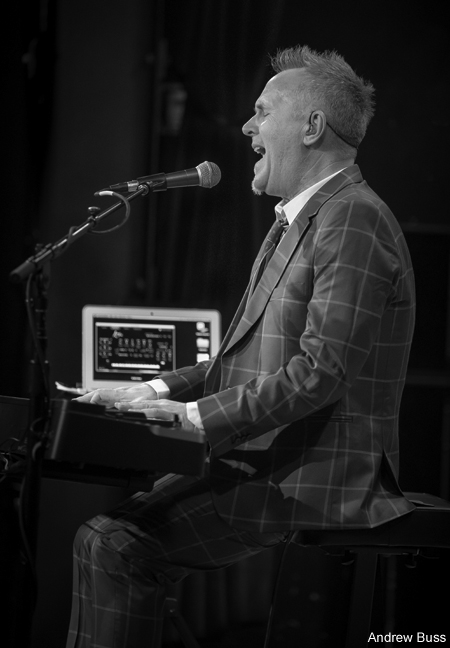
The Engage shows incorporate an iPhone and Android app that enables every concertgoer to participate in the gig. Describe the concept and what it took to make it happen.
I thought “Well, everyone’s got their phone with them, so let’s have them use them during the shows.” At first, I got people to download free apps like text scrollers and Fire. That was the easiest way to incorporate phones at first. But what I really wanted to do was have a custom Engage app in which we could trigger stuff on the audience’s phones from the stage. I thought it would be amazing to have all of these little screens in the audience reflecting what was going on back to us.
When I was doing one of the studio days with the fans, I mentioned that it was my dream to have an app you could open up during the show. There was a fan who was an app developer in attendance named Simon Fletcher who said he would love to do it. He worked night and day on it because there was a short time schedule to get it together for both iPhone and Android ahead of some shows. So, that’s another positive thing that came out of the PledgeMusic campaign. It worked out well because Simon followed my work and knew what I do really well. We supplied him with the loops of the visuals from the show and he was able to come up with a fantastic app. It’s still early days and I’m sure we can develop it into something really amazing in the future. Simon attended the Engage shows we did in London and Los Angeles. He would trigger the visuals from his iPad via Bluetooth burst recognition that phones have built in. It’s quite simple but we’re the first people to do it.
Several artists are now banning cellphones outright because they consider them a distraction. You’re doing the exact opposite by embracing them and allowing the audience to do whatever it wants with them during your shows. Tell me about your philosophy behind incorporating phones into the show.
I don’t have a problem with people using their phones at concerts. I think phones are a part of our lives. I use my phone all day just like everyone else does. I do believe if you’re only looking at your phone during a show that you’re going to miss a lot of stuff. But the thinking is when people used to go on holiday, they would write postcards to all their friends. Some would spend a whole day doing it just to tell them what a great time they were having. Cell phones are part of the same thing. People want to document what they’re doing so they can show friends they were there. It’s not a bad thing.
Telling people they can’t bring or use their phones at a concert is terribly imposing in my opinion. So, why not make the phone a part of the show? The app looks very cool when I’m looking out and seeing all these little images reflecting back at me. The audience enjoys it too. With this approach, people can choose their options. They can concentrate totally on the gig if they like. But if they want, they can interact through their devices as well.
Is there a certain irony in having a show called Engage with songs like “Human Touch” about face-to-face interaction, yet incorporating a world of electronic communication into it?
Engage involves using technology in a very creative way, but not forgetting about the real stuff. We do live in a world that uses technology, so I feel it’s quite important to not go “Well, everything technology has to offer isn’t any good.” I’ve been fighting that idea since I started. It’s ridiculous. Technology in and of itself is not bad. It’s neither good nor bad. It’s up to us to decide what to do with it. We’ve got to be vigilant about technology and ensure it’s working for us. Technology is capable of doing great things, but it can work against us as well. We have to be responsible. I love the fact that I can talk to people across the world from my computer. It’s wonderful and brings people together. At the same time, we’re hearing about lots of people worldwide who no longer engage with others in the real world anymore. They do it all through a screen. It’s a negative development that’s not good for us. We’ve got to ensure we make the right choices.
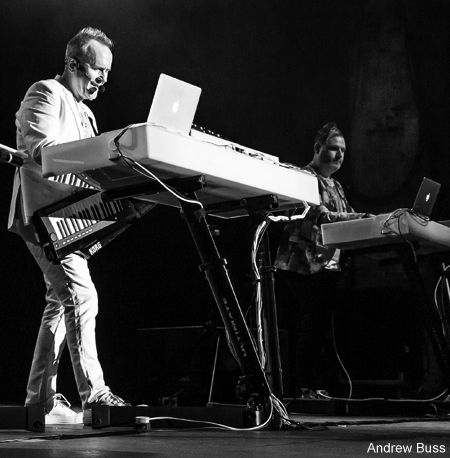
You’ve also brought a whole universe of interactivity to the Engage book. Talk about taking something as traditional as a printed book and transforming it into something more evolved.
We wanted to reflect the idea of being involved with the Engage book as well, so it has all of these fun tasks within it you can construct yourself. Throughout the book, there are things you can put your hands on so they come alive. The book reflects the major images of the shows. It includes a lenticular page at the back that moves. It has an acrylic front and back cover. It includes craft techniques, including seven different silk-screening passes on each page to get a major intensity of color. The embossing was done with a guy on a press, manually. The idea was at one end you have the app and at the other we’re doing something different with traditional media. I believe the two should coexist together.
Describe what’s going on behind the scenes during your performances.
One of the criticisms some have is that once a track starts, it’s on a set course and it can’t deviate. That’s not true. It can. If I couldn’t do that, there would be no sense of risk or improvisation in the show. My aim for the live shows has always been to use technology, but for it to be very flexible and similar to what it would be like if you had people playing together in a jazz trio. I still want to use precise electronic elements and sequenced stuff, but I also don’t want to be constrained by all of that. So, if I want to change the order of things or modify them, I can.
The Engage set is more like performing a symphony, so there’s not much change going on there from night to night, but everything else does have that flexibility built in. I’ve had that even when I started doing one-man shows. If I want to repeat a chorus, have a breakdown or change the order of things in a song, I can do it.
The members of my band play a key role in this. Jonathan Atkinson, the electronic drummer in the group, has all kinds of sounds programmed into his kit—not just typical drum sounds, but any kind of sound you can think of. He’s unique in that he’s a brilliant drummer, but also very knowledgeable about technology. He marries the two up very well. Robbie Bronnimann runs the main sequencer for the shows, which is Ableton. Each song is a series of chunks of verses, choruses and breakdowns. He’s controlling that order in conjunction with me. He can manipulate any element of that, so we can filter the sound, put effects on things, and grunge things up. He also plays keyboards and generates harmonies for my voice that go into his boxes.
Tell me about the 10-year plan that Engage kicked off for you.
I want to do another three projects, with Engage as the first part. I’d like to eventually perform them all over two nights, or one night if I can fit them all in. I’ve got tentative titles for all of them. The second one will be Transform, which discusses the idea that if we want to change the world for the benefit of everyone, first we have to start with ourselves. The third one is Dialog, which will be about the fact that we have to communicate with each other. We have to talk and thrash things out in order to communicate at the most profound level. The fourth piece is Global Citizen. It’s about our responsibility toward the planet. We’re part of a global group of human beings and I believe each and every one of us has to understand and embrace that.